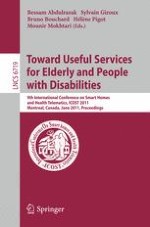2011 | Buch
Toward Useful Services for Elderly and People with Disabilities
9th International Conference on Smart Homes and Health Telematics, ICOST 2011, Montreal, Canada, June 20-22, 2011. Proceedings
herausgegeben von: Bessam Abdulrazak, Sylvain Giroux, Bruno Bouchard, Hélène Pigot, Mounir Mokhtari
Verlag: Springer Berlin Heidelberg
Buchreihe : Lecture Notes in Computer Science
